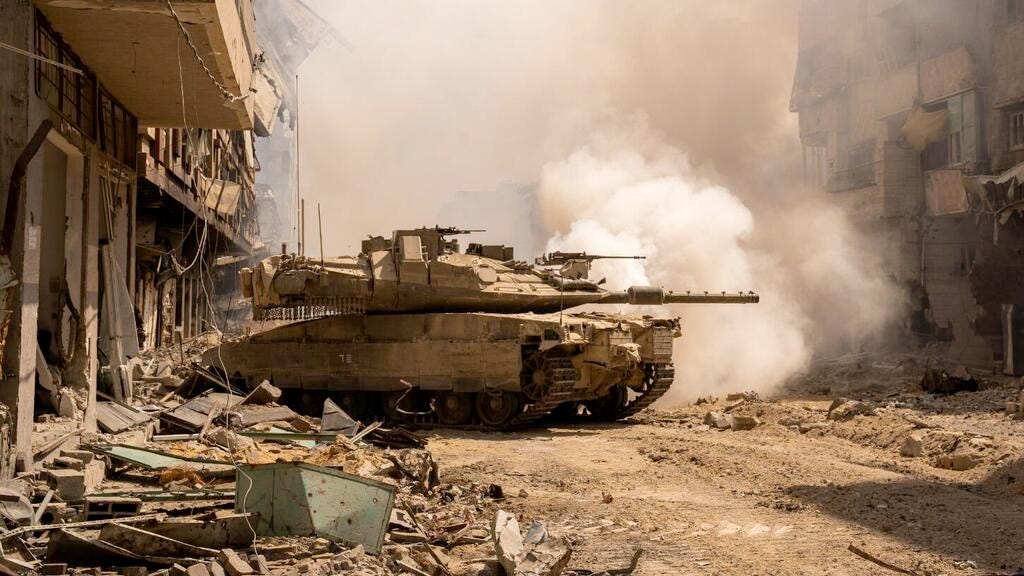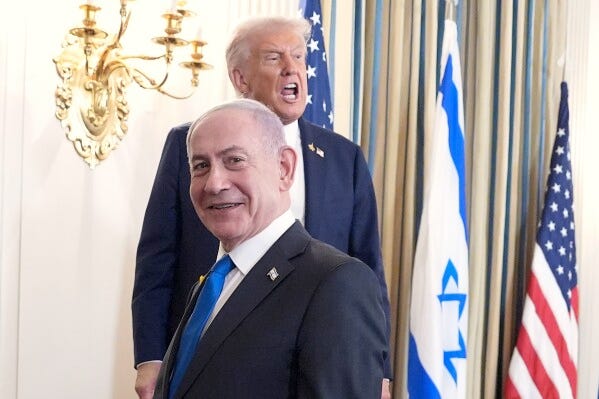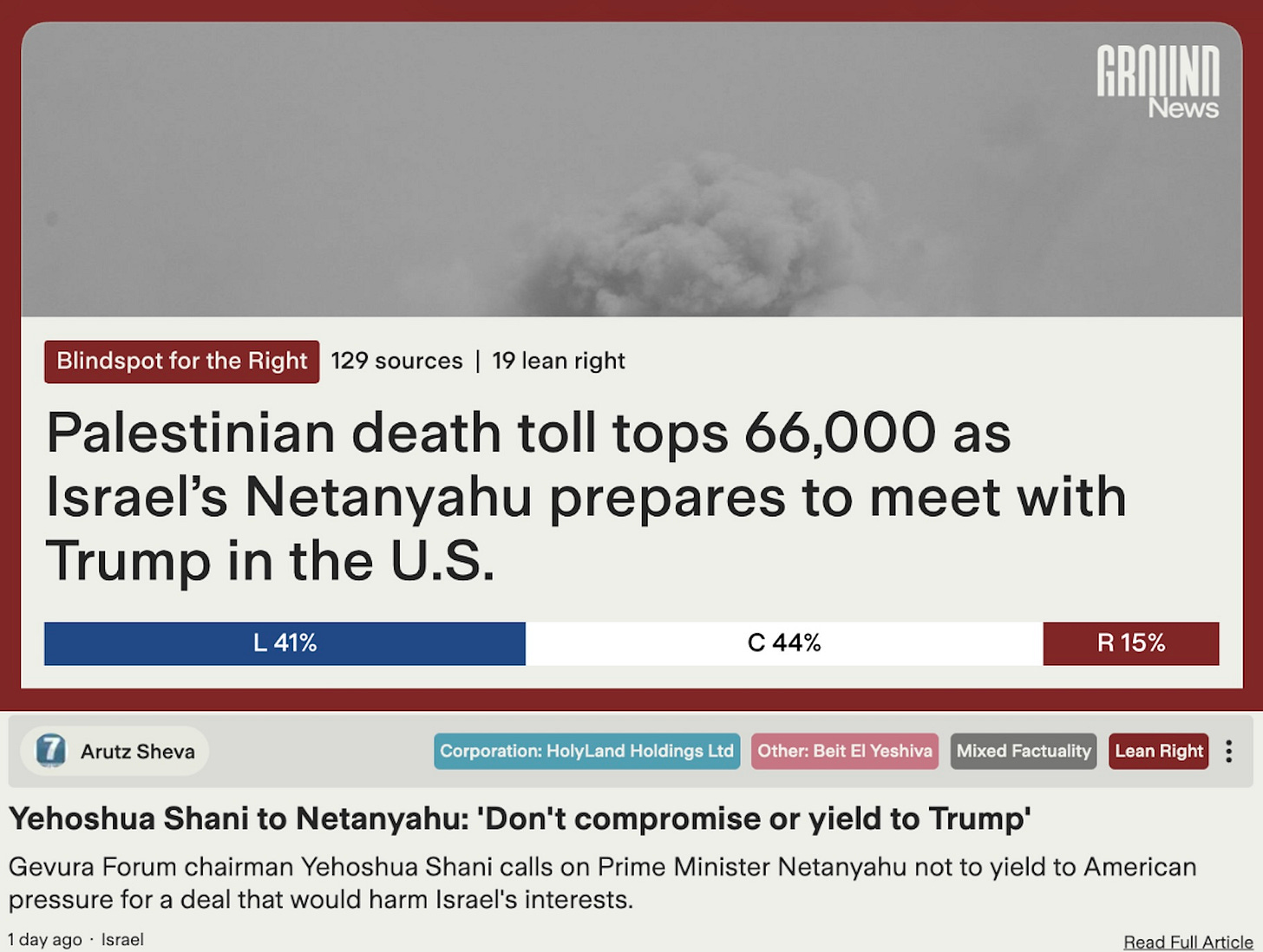Trump's Plan to End the Gaza War
Will Israel and Hamas agree?
This newsletter is sponsored by
Israeli tanks pushed deeper into Gaza City on Monday, closing in on the heart of what was once the territory’s largest urban center — just hours before Prime Minister Benjamin Netanyahu was due at the White House, where President Donald Trump promised “SOMETHING SPECIAL” in his latest bid to end the war.
As Israeli forces flattened neighborhoods and displaced hundreds of thousands more Palestinians, Trump and Netanyahu stood at podiums presenting perfect alignment. After nearly two years of failed diplomacy and more than 66,000 Palestinian deaths, Washington had finally put a comprehensive plan on the table. The question is whether the Israelis or Hamas will be willing to implement it.
Trump’s 20-point proposal, which the White House publicly released while the leaders met, calls for an immediate ceasefire, the release of all hostages within 72 hours, and a pathway — however distant — toward a two-state solution.
“Everybody who wants to see an end to the violence and destruction should be united in calling for Hamas to accept the extremely fair proposal,” Trump said after the meeting with Netanyahu at his side. The ultimatum was blunt: Hamas must accept his terms, which include conditions the group has already rejected, such as a full disarmament. If they don’t, Trump said Israel will have his “full backing to do what you would have to do” in Gaza.
Netanyahu expressed support. “I support your plan to end the war in Gaza,” he told Trump, “which achieves our war aims.” Trump, in turn, called Netanyahu a “warrior” and declared, “Israel is lucky to have him.”
Brutal math
As the two leaders met, Israel pressed ahead with one of its biggest offensives of the war.
Nearly all of Gaza’s 2.2 million residents have been displaced, many multiple times. Famine grips the north, while just 14 overwhelmed hospitals remain functional. Doctors Without Borders suspended operations as Israeli tanks circled within half a mile.
Israel’s defense minister had warned in August that Gaza City would become “like Rafah and Beit Hanoun”— two cities already destroyed. Another minister was blunter: “Gaza City itself should be exactly like Rafah, which we turned into a city of ruins.” Satellite images suggest the Israelis are delivering on those threats.
The destruction continued even as Trump promised peace. A senior Israeli official told a small group of reporters Friday that Israel believes that 20 hostages are still alive and the remains of 38 others are still in Hamas’s hands. Hostage families called Trump’s plan a “historic turning point,” urging Hamas not to derail progress. Hamas countered that two captives were in “real danger” after the terrorist group lost contact with their guards during Israeli operations.
The plan on paper
Trump’s framework resembles Biden’s three-stage proposal from 2024, which collapsed after six weeks. The main difference: Trump demands all hostages be released within three days, rather than in phases.
Humanitarian aid would flood Gaza immediately. Reconstruction would also begin immediately, including water systems, electrical grids, and sewage infrastructure. Hospitals and bakeries would receive emergency equipment. Palestinians would be encouraged to stay and offered “the opportunity to build a better Gaza” — a sharp reversal from Trump’s February suggestion that Gazans should leave en masse.
The plan offers amnesty for militants who renounce violence, safe passage for those who want out, and reconstruction of Gaza overseen by a transitional administration of yet-to-be-identified “qualified Palestinians and international experts.” Trump even offered himself as chair of a new “Board of Peace” to oversee Palestinian governance.
Under the proposal, an international stabilization force would secure Gaza while Palestinian police undergo training. Israeli troops would withdraw based on “milestones linked to demilitarization,” but with a catch: Israel could hold a buffer zone inside Gaza indefinitely until it deemed the territory “secure.” Netanyahu said forces would leave Gaza proper but remain in the perimeter “for the foreseeable future.”
The plan’s language on Palestinian statehood is equally vague, promising only a “credible pathway” once reforms are complete. Trump nodded to Netanyahu’s rejection of a Palestinian state, calling it “respected.”
Cracks beneath the surface
For all the public smiles, Trump and Netanyahu appear to disagree on what happens next. Netanyahu’s vision, emphasized Friday in his speech to the United Nations General Assembly, remains unchanged: “There will be no Palestinian state.” He wants Hamas destroyed, hostages freed, Gaza demilitarized and under indefinite Israeli security control — with forces remaining in a perimeter buffer “for the foreseeable future.”
The sticking point is the Palestinian Authority (PA), the government body that controls parts of the West Bank and has been the centerpiece of nearly every international peace plan. Netanyahu dismisses the group outright. Trump’s plan mentions the PA only after a “reform program,” which could mean anything — or nothing.
PA leader Mahmoud Abbas, denied a visa to the United States, addressed the UN by video, saying the PA was ready to govern Gaza once Hamas disarms. On Monday his government welcomed Trump’s “sincere and determined efforts” to end the Gaza war and pledged to work with the United States and its partners to implement his plan. But at 89, in the 20th year of a four-year term, Abbas presides over an unpopular institution widely considered corrupt. Netanyahu scoffed that sufficient PA reform would be “miraculous.”
Even during Monday’s meeting, tensions surfaced. Negotiations on a ceasefire had collapsed earlier when Israel bombed Hamas’s team in Doha, enraging Qatar and Trump. Netanyahu apologized personally to the Qatari prime minister in a Monday phone call during his meeting with Trump.
Hamas is a long shot
Hamas is unlikely to accept Trump’s plan in its current form, having consistently demanded a permanent end to the war and complete Israeli withdrawal before any further hostage release, while refusing the disarmament that anchors Trump’s proposal. Earlier Monday, Hamas said it was not consulted on the proposal.
The stakes in Gaza are no longer just political — they’re humanitarian. The death toll of Palestinians has now surpassed 66,000, according to Gaza’s Health Ministry. President Donald Trump hosted Israeli Prime Minister Benjamin Netanyahu to discuss a 21-point plan, including a proposed ceasefire and exchange of the hostages for a gradual withdrawal of Israeli forces. This meeting could shape the next phase of the conflict, influencing both regional stability and US involvement in the peace process
That’s why I think Ground News is one of the most important tools we have right now. I’m very intentional about what I recommend, so when I talk about Ground News — it’s for a reason.
I’ve been using their Vantage plan for nearly a year now, and here’s my takeaway: they’re an independent app and website designed to add clarity and context missing from our newsfeeds.
Their Blindspot Feed even shows us stories disproportionately covered by one side of the political spectrum, like this story, which has only 15% of the coverage coming from the right.
In a moment when so many institutions feel compromised, Ground News is one of the few tools I rely on that are filtering out the manipulation. Get my plan for 40% off — that’s $5 a month — at ground.news/preamble.
The timetable mismatch is glaring: the hostage release deadline is concrete: 72 hours. Israeli withdrawal, by contrast, has no set deadline. Netanyahu has already warned that if Hamas stalls, “we will finish the job.”
Echoes of failure
Netanyahu’s strategy recalls early steps in America’s own misadventures in regime change. In Afghanistan, the Taliban vanished only to reemerge as an insurgency. In Iraq, disbanding Saddam’s forces created a vacuum that ISIS filled. Gaza offers even less promise: shattered institutions, destroyed infrastructure, and a government unwilling to work with the only internationally recognized Palestinian leadership.
Even Israel’s generals are skeptical. Israel Defense Forces Chief of Staff Lt. Gen. Eyal Zamir warned that the Gaza City offensive lacked a “political endgame” and endangered hostages. An internal IDF report concluded the campaign had not met its basic objectives while Hamas enjoyed the conditions to survive.
Deepening isolation
Netanyahu’s problems stretch beyond Gaza. Britain, France, Canada, Australia, Belgium, and others recognized Palestinian statehood last week. Saudi Arabia, Egypt, the UAE, and Oman delivered coordinated UN warnings that the region was, in the Egypt’s foreign minister’s words, “at a point of implosion.”
In a joint statement Monday, the foreign ministers of Egypt, Jordan, the United Arab Emirates, Indonesia, Pakistan, Turkey, Saudi Arabia, and Qatar said they have confidence in Trump to find a way to peace.
Meanwhile, Netanyahu’s far-right coalition in the Israeli government demands continued fighting and rejects any Palestinian state outright. Some close to Netanyahu have already called Trump’s plan a “total failure.” Trump insisted Monday that Israelis want the war to end, but that will be a tall order if Netanyahu’s allies won’t tolerate withdrawal or PA involvement.
Without answers to the basic questions — who governs Gaza, who secures the territory, how Palestinians rebuild — Trump’s peace plan risks joining a large graveyard of failed Mideast peace diplomacy. Every one of its 20 points hides a minefield. As one displaced Gazan told reporters: “Trump has made promises in the past that all turned out to be fiction.”
Even if he manages to get signatures on paper, it’s far from clear Israel will stop fighting long enough for something lasting to be built from the rubble.













Seems like false hope. I find it difficult to believe Israel's far-right ministers will allow Netanyahu or Israel to accept a two-state solution.
You don't have to read between the lines. Just read direct quotes from them. They are incredibly transparent in their intentions and goals - which is to wipe out Gaza, move the Palestinian people, and settle the land with Israelis.
- Bezalel Smotrich has said the "Gaza Strip could be a "real estate bonanza" and that he is in talks with the US about dividing up the territory after the war - an idea previously condemned internationally. Speaking at an event in Tel Aviv [in Sept 2025], he said "a business plan is on President Trump's table... We've done the demolition phase... Now we need to build" (Source: BBC, https://www.bbc.com/news/articles/c5y59z6rznvo)
- Ben-Gvir said "that when the Gaza war ends, Israel must remain the sole ruler of the enclave. "Only the state of Israel. No one else. A full occupation of Gaza. Israeli control. Jewish settlement," he said, adding, "But that is not enough. There is another very important, essential step, which is encouraging emigration [of Palestinian people out]." (Source: https://www.timesofisrael.com/smotrich-says-gaza-to-be-totally-destroyed-population-concentrated-in-small-area/#:~:text=Finance%20Minister%20and%20Religious%20Zionism,4)
- Bezalel Smotrich's "vision for the Gaza Strip" is that "the population of the territory would be confined to just a narrow swath of land, with the remainder of the enclave “totally destroyed.”: “They will be totally despairing, understanding that there is no hope and nothing to look for in Gaza, and will be looking for relocation to begin a new life in other places.” (Source: Times of Israel: https://www.timesofisrael.com/smotrich-says-gaza-to-be-totally-destroyed-population-concentrated-in-small-area/#:~:text=Finance%20Minister%20and%20Religious%20Zionism,4)
These are just a few quotes directly from these Ministers / people in power themselves. I'm just directly quoting their own words. You all can interpret them as you wish.
If history has taught us anything in the Middle East, it's that if it's all or nothing, it'll be nothing.